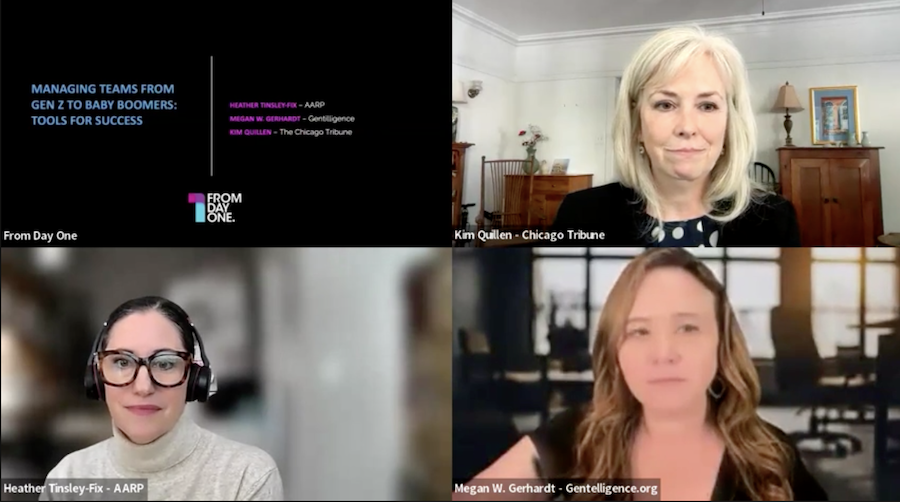Managing Teams From Gen Z to Baby Boomers: Tools for Success


Heather Tinsley-Fix, a senior advisor at AARP, was worried that an intern had been in a biking accident when he missed work for an entire week and didn’t call. When he returned to work and she asked him to explain the absence, she quickly found a difference in generational norms.
In college, the intern wasn’t obligated to notify professors if he was missing a class, and he thought that’s how things worked in his new workplace. “Once I understood that, I said, ‘Okay, I get that. That makes sense,’” Tinsley-Fix recalled during a From Day One webinar. “It’s about trying to get underneath what the behavior is that's bothering you as a manager,” she said.
Such misunderstandings are increasingly common in today’s workplace, where as many as five generations work side by side. During the session, Tinsley-Fix and Megan Gerhardt, Ph.D., founder of Gentelligence, both acknowledged that while age diversity can be a source of friction in the workplace, it can also be a significant competitive advantage. The key is moving beyond stereotypes and learning to harness each person’s unique strengths.
The Case for Generational Intelligence
Multi-generational teams are the new normal, and there’s a strong business case for fostering what Gerhardt calls “generational intelligence.”
“There’s research that shows that mixed-age teams perform better on complex and creative tasks than teams which are more homogenous in age,” Tinsley-Fix said. “As you add generational diversity to teams, the quality of the decisions goes up.”

This “cognitive diversity” introduces a breadth of professional experience and healthy tension that can spark innovation. The challenge in managing multi-generational teams isn’t the differences between team members, but how they’re handled. Left unchecked, these differences can lead to stereotypes and judgment. When managed with intention, they become a catalyst for growth.
A Four-Step Framework for More Productive Conversations
Gerhardt outlined a four-step framework in her book, Gentelligence: The Revolutionary Approach to Leading an Intergenerational Workforce, to improve collaboration within multi-generational teams. These are:
Navigating Workplace Friction: Mental Health and Professionalism
Younger generations, particularly Gen Z, often have different expectations regarding mental health and professionalism due to coming of age during the pandemic, says Gerhardt.
They are more likely to expect mental health support from employees and are more open to conversations about the subject. This can create contention with older workers who were raised in a different era when employers expected them to “leave their problems at the door.”
“Neither is right nor wrong,” Gerhardt said. “But those people are working together and trying to navigate a workplace with very different norms.”
Similarly, the very definition of the term “professionalism” varies from generation to generation. For example, an older manager might find a team member leaving their phone on the table during a business lunch as rude, while a younger employee thinks it helps them stay connected and responsive.
“If you don’t realize the person sitting across the table from you that is going to potentially offer you a job will find this very rude, then you do have a problem, regardless of whether or not it is something you feel is rude,” Gerhardt added. The solution isn’t to dictate one right way, but to have explicit conversations about shared standards and the “why” behind them.
Seek the Advantage
Gerhardt’s advice for managers looking to improve their ability to manage age-diverse teams is to gain as much experience working with people of all ages. “Once you are able to learn something from someone significantly older or younger that you weren’t able to figure out on your own, you get hungry for more,” Gerhardt said. “That’s how you change your own mindset. That’s how you change the workplace culture that you’re in.”
Editor’s note: From Day One thanks our partner, AARP, for sponsoring this webinar.
We’re looking for organizations to partner with AARP’s Generations at Work program to gain early access to the product, insights on bridging generational differences, input on the final design, and custom guidance to strengthen your workforce strategy. Fill out this brief survey if your company would like to be a part of this opportunity or you just want to learn more about the pilot program: https://surveys.fromdayone.co/aarp2025
Ade Akin covers workplace wellness, HR trends, and digital health solutions.
(Photo by Marco VDM/iStock)
The From Day One Newsletter is a monthly roundup of articles, features, and editorials on innovative ways for companies to forge stronger relationships with their employees, customers, and communities.